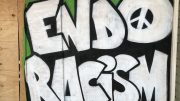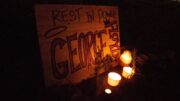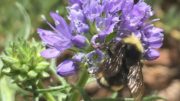Is Sacramento ready for the next big wildfire?
Sacramento wasn’t ready for the smoke that billowed south from November’s Camp Fire, the deadliest and most destructive fire in California history.
Public health officials advised people to stay inside, but that’s easy only if you have a home and work in an office. They told schools to keep students indoors where air is cleaner, but school air filtration systems vary in quality. The city of Sacramento handed out disposable N95 masks, which when worn properly protect lungs by filtering particles in the air. But Sacramento County Public Health warned people not to wear them.
When the smoke was at its thickest, Northern California’s air quality was rated worst worldwide. What made the air so unhealthy was the presence of fine particulate matter small enough to travel deep into lungs. Smoke was all the more toxic because it contained not just burned trees, but burned homes, cars and electronics.
Scientists are still researching the long-term effects of wildfire smoke. Sacramento region and Bay Area emergency rooms saw a spike in respiratory and cardiac complaints months after the October 2017 Tubbs Fire in Sonoma County, according to an analysis of state health planning data by the Center for Investigative Reporting. The figures showed a 20 percent increase in patients reporting heart and lung problems during the first quarter of 2018 compared to previous years. Corresponding data for the Camp Fire is not yet available.
“The unfortunate thing is because of climate change, this is only going to get worse,” said Alberto Ayala, executive director of the Sacramento Metropolitan Air Quality Management District. Hotter, drier weather persisting later into the year, due to rising average global temperatures, helped fuel the Camp Fire’s devastation.
Sacramento area public health and emergency management agencies are working to improve their response the next time the air turns gray.
They’re aiming for more consistent messaging on when to wear masks, and on getting better air quality information to the public. They plan to open clean air centers and monitor indoor air quality more closely. And they’re hoping to offer better guidance to workplaces and schools unsure of whether to remain open and how to best protect workers and students.
Communication breakdown
Two images are most evocative of Sacramento during the Camp Fire—yellowed gray haze and white face masks. The second is emblematic of problems in how public officials responded to the first.
The city of Sacramento started offering N95 masks supplied by the county at fire stations on November 11. That same day, Sacramento County Public Health directed the county to stop supplying them, declaring that the risks of wearing the masks outweighed the benefits.
These masks are less effective for people with beards, are not designed to fit children’s faces and restrict breathing in a way that can be detrimental for people with heart and lung conditions. They must be disposed of regularly, or bacteria can collect, potentially causing infections. People may mistakenly believe that wearing a mask lets them exercise outdoors in poor air quality without harming their health.
Despite the county’s directive, the city acquired masks from the state and continued distributing them. At some times, fire stations ran out.
The 24-hour average in Sacramento County of air-suspended fine particulate matter with a diameter of less than 2.5 micrometers peaked at 263.6 micrograms per cubic meter of air, according to preliminary data from the air quality district. That translates to an Air Quality Index reading of 314 or “hazardous.”
For comparison, the 24-hour average in the Bay Area during the Tubbs Fire was 199.1 micrograms, equivalent to an Air Quality Index of 249 or “very unhealthy.”
Maybe in an ideal world, everyone would stay inside most of the time during poor air quality, and would not wear masks without consulting their doctors or getting fit-tested by their employers.
But real life is messier. Some people are homeless. Some work outside. And whatever their situation, when people do have to be outside even for short periods, they naturally want to protect themselves from smoke.
Five months after the Camp Fire, with summer around the corner, it’s unclear how the messaging on N95 masks will be different. The California Department of Public Health said it is “developing a local health officer guidance that will include a list of considerations for how and when to use N95s.”
Sacramento County Public Health spokesperson Brenda Bongiorno said the agency plans to update its guidance once that happens.
The people outside
On March 21, the California Occupational Safety & Health Standards Board approved a petition from the California Labor Federation, Worksafe and the California Rural Legal Assistance Foundation to develop precautions for outdoor workers exposed to wildfire smoke.
“Exposure to fine particulate matter can reduce lung function, worsen heart and lung conditions, and cause coughing, wheezing and difficulty breathing,” the petition said, describing the need for protections as “urgent.”
The board plans to create temporary policy through expedited emergency rule-making and follow-up with permanent measures through standard rule-making. The last time the board used the faster process was to initiate heat illness prevention measures in 2005, when 10 farm workers died of heat stress, according to a board spokesperson.
Besides farm workers and others who toil outside, homeless people are especially vulnerable to wildfire smoke.
Even when Sacramento public health officials told people not to wear the air filtering masks, Armando Flores gathered as many as he could from stores and volunteers and handed them out to as many as 400 homeless people in November.
“The homeless people are already in a bad position to be living on the streets,” he said. “They’re not welcome in too many places.”
Flores handed out alcohol wipes to clean masks in hopes they could be used longer. Though that’s not recommended, he didn’t see other options.
“Other than that we didn’t have enough resources,” he said.
Flores, who owns a hair salon near Arden Fair Mall, provides food and materials to area homeless twice weekly through his volunteer organization CAFFE (Clothing And Food For Everyone.) Late one March afternoon outside Sacramento City Hall, Flores and volunteers served a warm dinner to people lined up along the sidewalk.
Kim McGee, 46, standing in line with her bike, said she spent the days of the Camp Fire in and out of the downtown public library. At night, “we just slept outside.” She tried to wear an N95 mask as she slept, but took it off because it was uncomfortable.
Mornings, she strapped a mask onto the face of her 8-year-old and sent him to school. The masks are not designed to fit children.
Billy “Saint” Pineda, 23, described air during the Camp Fire as “thick.” He has asthma and scar tissue in his lungs, which made it harder to cope, though he was able to get several N95 masks. Eventually, he purchased something heavier duty at an army surplus store.
“I realized that it was, like, too hard to breathe without the masks,” he said.
Clean air centers
Perhaps the most potentially costly response the city of Sacramento is now considering is to test clean air centers the next time air quality gets really bad, whether from wildfire smoke, ozone or other reasons.
These centers would work similarly to the city’s existing warming and cooling centers, which open based on meeting certain temperature thresholds and other benchmarks. Those thresholds have raised concerns, however. A homeless man died in February when temperatures dropped into the 30s, but warming centers weren’t open. The county coroner, however, now says the man died from a drug overdose.
Engineers in the city Public Works Department are assessing potential sites for clean air centers to determine if they need more equipment. The city does not yet have estimates for how many centers or how much they will cost.
“I definitely think we’re treading into new territory,” said Daniel Bowers, the city of Sacramento’s director of emergency management.
Ayala sees potential for schools to contain clean air centers, so that students can be supervised and safe from poor air quality even if classes are canceled. “Could we equip and retrofit, let’s say, the multipurpose room at a school with some high-efficiency filtration?” he asked.
Air quality indoors is generally better than outside during periods of heavy smoke, but harmful particles can still get inside, so improvements to air filters may be necessary.
During the Camp Fire, the office of California Air Resources Board monitored air quality inside its own offices in downtown Sacramento. Fine particulate matter concentration peaked at an unhealthy 150 particles per cubic meter of air. Air quality improved when the board replaced office air filters with heavier duty ones.
The Sacramento Metropolitan Air Quality Management District used consumer air monitors inside its building and saw troubling readings. “I was smelling it in my office and I knew it was bad,” Ayala said.
Protecting students
Clean air centers in schools are probably a ways off. In the meantime, school districts must determine whether to keep their buildings open the next time there’s severe smoke from wildfires during the school year.
While the California Department of Education said it is working with the Air Resources Board and legislators on guidance for school districts and county offices of education, decisions on whether to close remain up to local school districts.
Closing schools causes a lot of challenges. Parents have to decide whether to stay home, which can mean loss of income, which is even harder on poorer families. When parents can’t stay home, kids go unsupervised and may play outside in unhealthy air.
Even if children stay inside, home air quality isn’t necessarily better than at school. Sacramento County Public Health Officer Olivia Kasirye said her agency plans to educate the public this summer about how to create clean air spaces in homes. Depending on the age of a house, how well insulated it is and the type of ventilation, creating such a space may be more or less challenging.
Area universities and colleges face similar decisions as schools. During the Camp Fire, Sacramento State monitored indoor air quality in buildings where critical employees were required to work while the rest of campus shut down. The campus plans to do the same should the situation recur, said Gary Rosenblum, associate vice president for risk management.
Los Rios Community College District plans to test clean air monitors indoors, and if certain buildings are found to maintain better air quality, “we would likely direct people to those places in case of a spike in poor air quality,” according to district spokesperson Gabe Ross. But if the air gets too bad, campuses will be shut down as they were during the Camp Fire, he said in a statement.
Ayala envisions the air quality district one day serving as a clearinghouse for monitors, so it could calibrate them for schools and other organizations. He also believes the district can predict wildfire smoke conditions perhaps two days in advance, making it easier for school officials to decide earlier whether to cancel classes.
More resources needed
One hurdle to improving response to wildfire smoke is resources. Offering the public new tools and solutions is going to cost money.
Assemblywoman Buffy Wicks, an Oakland Democrat, has introduced a bill that would grant an unspecified amount of funding to the Bay Area Air Quality Management District to retrofit ventilation systems in certain public buildings and develop a network of clean air centers. Cap-and-trade is one potential source of funding.
The bill could be expanded to other regions of the state, said Wicks’ office. Ayala said he hopes the Sacramento region will benefit. Bowers said the city plans to move forward with its clean air center pilot whether there is state money or not.
One lesson from the Camp Fire is that public agencies weren’t prepared for the unprecedented intensity of recent wildfire smoke, and they still don’t know exactly how to respond. But speedy response is crucial to limiting harm to human health.
How much time does Sacramento have before the next big fire?
“I mean, it could happen this weekend,” Bowers said.






Leave a comment